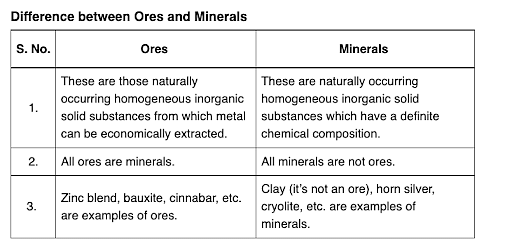Extraction of copper by smelting uses silica as an additive to remove :
- ${Cu_2 S}$
- ${FeO}$
- ${FeS}$
- ${Cu_2O}$
The Correct Option is B
Solution and Explanation
$[FeO + SiO_3 \to FeSiO_3 ]$
Top Questions on General Principles and Processes of Isolation of Elements
- In the extraction of iron using blast furnace to remove the impurity (X), chemical (Y) is added to the ore. X and Y are respectively
- TS EAMCET - 2025
- Chemistry
- General Principles and Processes of Isolation of Elements
- What is used for the Thermite Reaction?
- BCECE - 2025
- Chemistry
- General Principles and Processes of Isolation of Elements
- Which of the following compounds is used to cover the surface of a metallic object to prevent corrosion?
- KEAM - 2025
- Chemistry
- General Principles and Processes of Isolation of Elements
A block of mass 1 kg is pushed up a surface inclined to horizontal at an angle of \( 60^\circ \) by a force of 10 N parallel to the inclined surface. When the block is pushed up by 10 m along the inclined surface, the work done against frictional force is:

[Given: \( g = 10 \) m/s\( ^2 \), \( \mu_s = 0.1 \)]
- BITSAT - 2024
- Physics
- General Principles and Processes of Isolation of Elements
A parallel plate capacitor with plate area \(A\) and plate separation \(d = 2\) m has a capacitance of \(4\mu F\). The new capacitance of the system if half of the space between them is filled with a dielectric material of dielectric constant \(K = 3\) (as shown in the figure) will be:

- BITSAT - 2024
- Physics
- General Principles and Processes of Isolation of Elements
Questions Asked in JEE Main exam
- The formation enthalpies, \( \Delta H_f^\circ \) for \( \text{H}_2 \) and \( \text{O}_2 \) are 220.0 and 250.0 kJ mol\(^{-1}\), respectively, at 298.15 K, and \( \Delta H_f^\circ \) for \( \text{H}_2\text{O} \) (g) is -242.0 kJ mol\(^{-1}\) at the same temperature. The average bond enthalpy of the O-H bond in water at 298.15 K is:
- JEE Main - 2025
- Thermodynamics
- In a group of 3 girls and 4 boys, there are two boys \( B_1 \) and \( B_2 \). The number of ways in which these girls and boys can stand in a queue such that all the girls stand together, all the boys stand together, but \( B_1 \) and \( B_2 \) are not adjacent to each other, is:
- JEE Main - 2025
- Permutations
For the AC circuit shown in the figure, $ R = 100 \, \text{k}\Omega $ and $ C = 100 \, \text{pF} $, and the phase difference between $ V_{\text{in}} $ and $ (V_B - V_A) $ is 90°. The input signal frequency is $ 10^x $ rad/sec, where $ x $ is:

- JEE Main - 2025
- AC Circuits
Two parabolas have the same focus $(4, 3)$ and their directrices are the $x$-axis and the $y$-axis, respectively. If these parabolas intersect at the points $A$ and $B$, then $(AB)^2$ is equal to:
- JEE Main - 2025
- Parabola
A point particle of charge \( Q \) is located at \( P \) along the axis of an electric dipole 1 at a distance \( r \) as shown in the figure. The point \( P \) is also on the equatorial plane of a second electric dipole 2 at a distance \( r \). The dipoles are made of opposite charge \( q \) separated by a distance \( 2a \). For the charge particle at \( P \) not to experience any net force, which of the following correctly describes the situation?

- JEE Main - 2025
- Electrostatics and Work Done by Electric Field
Concepts Used:
General Principles and Processes of Isolation of Elements
What are Ores and Minerals?
Minerals are the naturally occurring, homogeneous inorganic solid substances. They are having a definite chemical composition and crystalline structure, hardness and color. For example, copper pyrite, calamine, etc.

Impurities in an ore are called gauge. The removal of a gauge from the ore is called concentration ore.
Several steps are involved in the extraction of pure metal from ores. Major steps are as follows –
- Concentration of the ore
- Isolation of the metal from its concentrated ore
- Purification of the metal